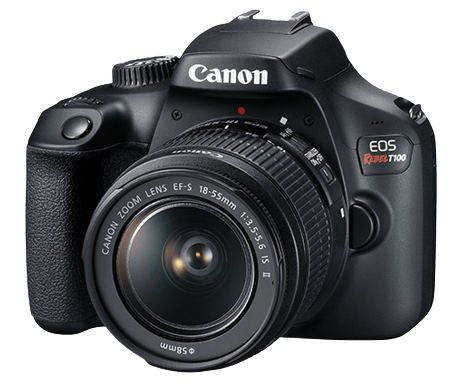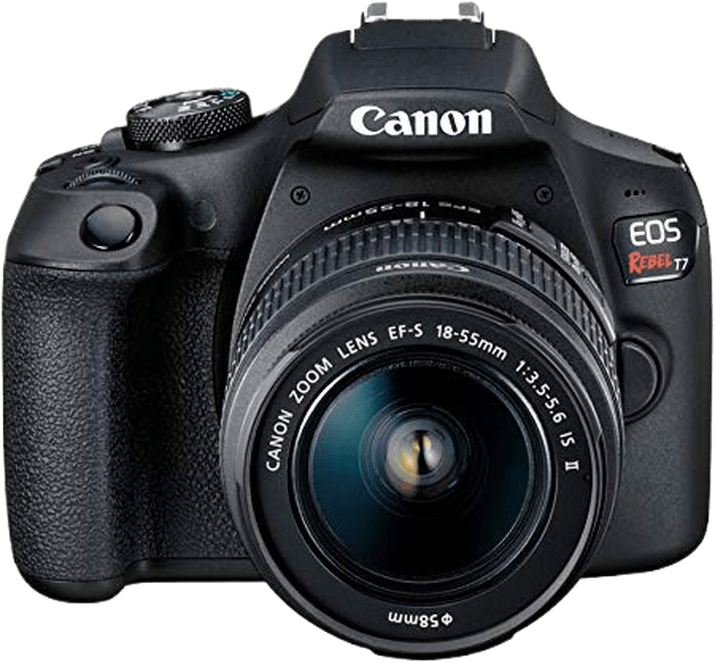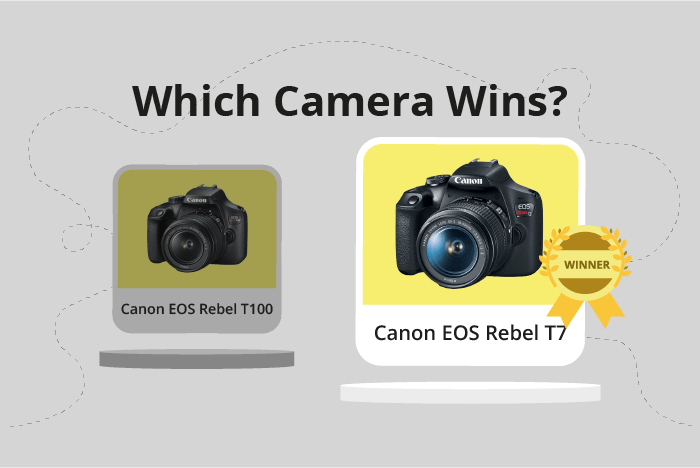Canon EOS Rebel T100 / 4000D vs EOS Rebel T7 / 2000D Comparison
Canon EOS Rebel T100 / 4000D

Canon EOS Rebel T7 / 2000D

The Canon EOS Rebel T7 / 2000D outperforms the Canon EOS Rebel T100 / 4000D with a score of 50/100 compared to 41/100. Both cameras share several specs, including being DSLR cameras, announced on 02/26/2018, released in the same year, and having similar dimensions.
The T7 / 2000D’s higher score reflects its superior quality. It justifies its higher launch price of $550 compared to the T100 / 4000D’s $400. However, the T100 / 4000D has a slight advantage in weight, being lighter at 475g compared to the T7 / 2000D’s 660g.
Considering these factors, the Canon EOS Rebel T7 / 2000D is the better choice for those seeking higher quality, while the Canon EOS Rebel T100 / 4000D may be more suitable for those prioritizing a lighter camera at a lower cost.
Canon EOS Rebel T100 / 4000D vs EOS Rebel T7 / 2000D Overview and Optics
The Canon EOS Rebel T7 / 2000D emerges as the winner in the optics comparison with a score of 56/100, while the Canon EOS Rebel T100 / 4000D trails behind at 39/100. Both cameras share some common specifications, such as a shooting speed of 3 fps, a CMOS sensor, a Digic 4+ processor, an APS-C sensor size, a Canon EF-S lens mount, and a lack of image stabilization.
The T7 / 2000D outperforms the T100 / 4000D in several aspects. It boasts a higher megapixel count of 24.1, compared to the T100 / 4000D’s 18 megapixels. This difference allows the T7 / 2000D to capture more detailed images. Furthermore, the T7 / 2000D has a higher DXOMARK score for its sensor at 71, while the T100 / 4000D scores 63. The superior sensor performance in the T7 / 2000D contributes to better image quality and low-light performance.
On the other hand, the T100 / 4000D does not have any notable advantages over the T7 / 2000D in terms of optics. Both cameras share the same shooting speed, sensor type, processor, sensor size, lens mount, and lack of image stabilization.
Taking all these factors into consideration, the Canon EOS Rebel T7 / 2000D is the better camera in terms of optics. Its higher megapixel count and superior sensor performance make it a more suitable choice for photographers seeking better image quality. The Canon EOS Rebel T100 / 4000D, despite lacking any significant advantages in this area, remains a viable option for those on a tight budget or looking for an entry-level DSLR.
Canon EOS Rebel T100 / 4000D vs EOS Rebel T7 / 2000D Video Performance
When comparing the video capabilities of the Canon EOS Rebel T100 / 4000D and the Canon EOS Rebel T7 / 2000D, both cameras have the same video score of 43 out of 100. This score shows that neither camera has a significant advantage over the other in terms of video performance.
Both the T100 / 4000D and the T7 / 2000D share common video specifications. They both have a maximum video resolution of Full HD and maximum video dimensions of 1920 x 1080. Additionally, both cameras have a maximum video frame rate of 30fps. Neither of these cameras has time-lapse functionality built in, which means users will need to use external software to create time-lapse videos.
Since both cameras have identical video scores and specifications, it is difficult to determine a clear winner in terms of video capabilities. However, it is worth noting that both cameras offer decent video quality for beginner and intermediate users, with Full HD resolution and 30fps frame rate providing smooth and detailed footage.
Despite their similar video performance, other factors such as price, build quality, and additional features might influence a potential buyer’s decision. It is essential to consider these factors alongside video capabilities when choosing between the Canon EOS Rebel T100 / 4000D and the Canon EOS Rebel T7 / 2000D.
Taking into account the video capabilities alone, both cameras are evenly matched. Buyers should look at other aspects of the cameras to determine which best suits their needs and preferences.
Canon EOS Rebel T100 / 4000D vs EOS Rebel T7 / 2000D Features and Benefits
The Canon EOS Rebel T100 / 4000D emerges as the winner with a feature score of 47/100, while the Canon EOS Rebel T7 / 2000D scores 41/100. Both cameras share common specifications, including the absence of a touchscreen and GPS. They also offer WIFI connectivity, enabling easy transfer of photos and videos to other devices.
The T100 / 4000D has a smaller screen size of 2.7 inches compared to the 3-inch screen of the T7 / 2000D. However, the T100 / 4000D’s screen resolution is significantly lower at 230,000 dots, compared to the T7 / 2000D’s 920,000 dots. The T100 / 4000D also has a Bluetooth feature, which is absent in the T7 / 2000D. This allows for seamless connection with compatible devices and remote control options.
The T7 / 2000D, on the other hand, boasts a flip screen, giving users more flexibility in capturing images from various angles. This can be particularly useful for vloggers and photographers who require versatile shooting options. The T7 / 2000D’s higher screen resolution provides a clearer and more detailed image preview, which can be beneficial for precise focus and composition.
Taking these points into consideration, the Canon EOS Rebel T100 / 4000D’s higher feature score is mainly due to its Bluetooth capability, while the Canon EOS Rebel T7 / 2000D offers a better screen with flip functionality. Both cameras cater to different preferences, with the T100 / 4000D being suitable for those who prioritize connectivity, and the T7 / 2000D being a better choice for users who value screen quality and flexibility.
Canon EOS Rebel T100 / 4000D vs EOS Rebel T7 / 2000D Storage and Battery
The Canon EOS Rebel T100 / 4000D and the Canon EOS Rebel T7 / 2000D have identical storage and battery scores, both at 27/100. They share the same specifications in this category, with each camera having one memory card slot, accepting SD, SDHC, and SDXC cards. Both cameras also have a battery life of 500 shots, using the same LP-E10 battery type. Neither camera offers USB charging.
Since both cameras have the same storage and battery specifications, there is no clear winner in this aspect. The Canon EOS Rebel T100 / 4000D and the Canon EOS Rebel T7 / 2000D provide equal performance in terms of storage capacity and battery life. Therefore, users can expect similar experiences when using either camera for their photography needs.
Canon EOS Rebel T100 / 4000D vs EOS Rebel T7 / 2000D – Our Verdict
Are you still undecided about which camera is right for you? Have a look at these popular comparisons that feature the Canon EOS Rebel T100 / 4000D or the Canon EOS Rebel T7 / 2000D:

